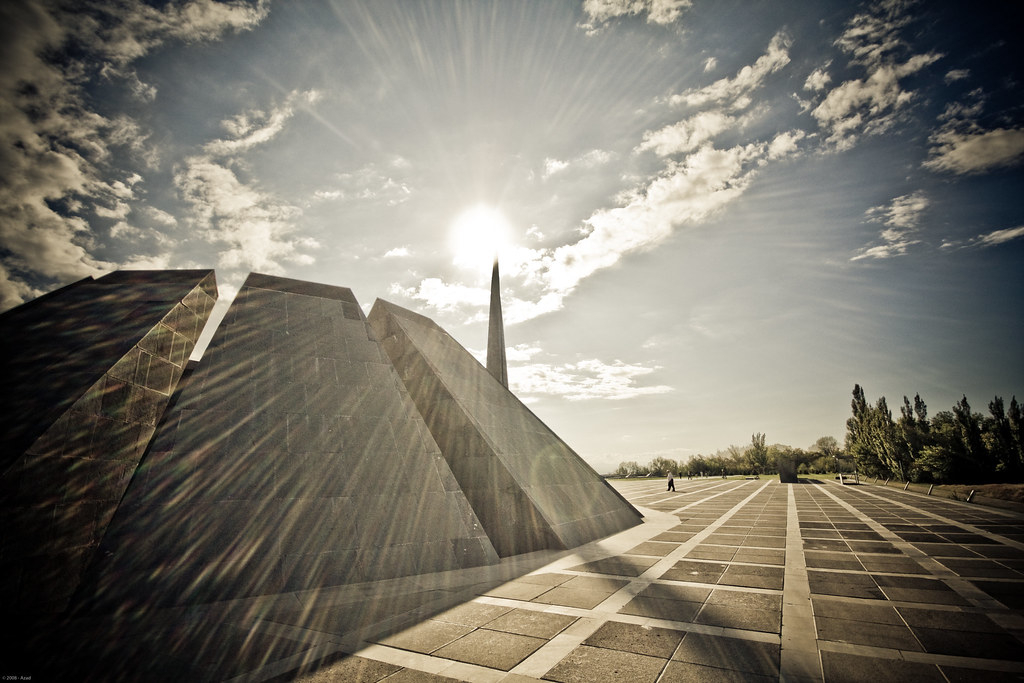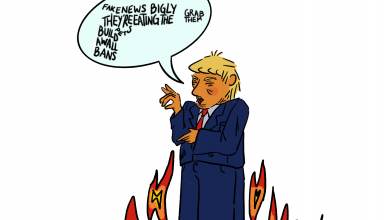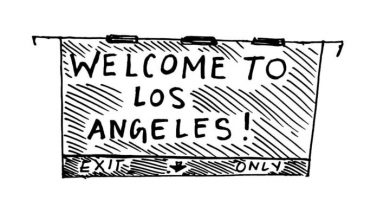Denial and Diaspora: The Armenian Genocide of 1915

Armenian Genocide Memorial in Yerevan, Armenia.
Photo Credit to DziDzernagapert via Flickr Attribution 2.0 Generic (CC BY 2.0)
April 24 commemorates the loss of over 1.5 million Armenians at the hands of the Ottoman Empire during World War I. This mass annihilation of people is recognized globally as the Armenian Genocide of 1915.
Under the pretense of war, the rulers of the Ottoman Empire, known as “The Young Turks,” ordered the mass murder of the Armenian population, a community of people who had resided on the highlands between the Black, Caspian, and Mediterranean seas for over 3,000 years. The Ottoman Turks had long promoted the idea of “pan-Turkism,” or the idea of a homogenous Turkic state, and saw the Armenian minority as a threat to this plan.
On April 24, 1915, Ottoman authorities ordered the arrest of hundreds of Armenian intellectuals throughout the empire. Those arrested were political leaders, scholars, physicians, writers, and religious figures. This “decapitation strike” was intended to deprive the Armenian population of leadership and a chance to survive the horror that would be unleashed upon them.
The Armenian Genocide was a premeditated, systematic removal of an entire population from the Ottoman Empire. Ottoman authorities organized a series of death marches to exile hundreds of thousands of Armenians from the Ottoman Empire and into the Syrian desert. Armenians faced abuse, starvation, illness, dehydration, and injury along the way. Those who survived the journey were murdered upon arrival to the desert. The authorities also formed “killing squads,” made up of convicts and murderers, to drown, burn, and torture Armenians to death. From 1915 until the early 1920s, over 50 percent of the Armenian population was annihilated.
It would take another quarter of a century for the international community to fathom a term for such atrocities. In 1943, Raphael Lemkin, a lawyer of Polish-Jewish descent, coined the term genocide by utilizing the Ancient Greek word “genos” (race, tribe) and Latin “cide” (killing). Lemkin defines genocide as the destruction of a nation or of an ethnic group. In 1948, the United Nations authorized the Convention on the Prevention and Punishment of the Crime of Genocide, which formally made genocide a crime under international law.
Dr. Gregory Stanton, President of Genocide Watch and research professor of Genocide Studies at George Mason University, analyzed the process of genocide and divided the crime against humanity into stages, known as the “Ten Stages of Genocide.” The tenth and final stage of genocide is denial; the act of denying a genocide prevents the ability of the affected population to begin the mourning process. Whereas the wounds of survivors and descendants of survivors of genocide are not visible, they are still very much open due to intergenerational trauma. The act of denial condones genocide.
For centuries, the term “genocide” did not exist. For centuries the world has witnessed this crime repeatedly happen. Countless perpetrators in positions of power have not been brought to justice. Indigenous and Aboriginal peoples around the globe, from the United States to the Australian continent, experienced genocide from the very beginning of European exploration and imperialism. The Jewish Holocaust (1941), Cambodian Genocide (1975), Guatemalan Genocide (1981), Bosnian Genocide (1992), and Rwandan Genocide (1994) are only a few of the mass atrocities that have also taken place during the twentieth century. The Rohingya Muslims of the country of Myanmar continue to be systematically murdered in large numbers by their country’s government. Recently, President Donald Trump called undocumented refugees and migrants from Latin America “animals,” referring to this group in dehumanizing terms that political commentators have argued resemble one of the ten steps of genocide. The failure of the international community to recognize and combat the act of genocide until the mid twentieth century and even now wrongfully trivializes human life.
In 1939, Adolf Hitler asked, “Who after all, speaks today of the annihilation of the Armenians?” I am the great granddaughter of survivors of the Armenian Genocide. Though I live in the diaspora, my heart remains in the highlands. I have memorized by heart the story of a young Levon Nalbandian who was captured by Ottoman authorities and forced to march from the town of Urfa with his mother and sisters after their father, a prominent businessman, was brutally murdered in front of their eyes. After witnessing the abuse and death of his mother and each of his sisters, this young boy managed to escape from the hands of authorities and run to Haifa in present-day Israel. There, he met an Armenian woman with whom he would start a family. My great-grandfather penned a memoir about his experience. His story and ancestral lineage remains alive.
To this day, neither Turkey nor the United States have recognized the Armenian Genocide. The wounds of survivors and their descendants are still open. For over a century, the governments of these nations have denied the Armenian population the chance to heal by disregarding that such an occurrence took place. Each year, diasporic communities around the globe unite on April 24 to commemorate the 1.5 million who perished.




